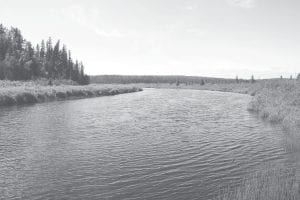When legislation passed this summer allowing Lutsen Mountains Corporation (LMC) to extract up to 150 million gallons of water per year from the 23-mile-long Poplar River, it was believed that would adequately address the ski hill’s need for water for snowmaking operations. However, the legislation also prohibited extraction if the river’s flow is lower than 15 cubic feet per second (cfs) for five consecutive days. On October 26, 2011, the Minnesota Department of Natural Resources (DNR) reported that the flow of the Poplar River has been “at or near the threshold for weeks.” However, the DNR can, under a separate provision of Minnesota statutes, issue a permit allowing the continued use if there is a “just cause.”
According to the DNR, the average flow for the Poplar River in November is 86 cfs. It has been hovering around 20 cfs for some time, and will likely drop significantly during winter, when limited water drains into the river.
Normally, pumping operations would be discontinued due to the river’s low flow, but the October 26 statement from the DNR stated that “the DNR believes there is just cause to issue LMC a permit based on the potential economic impacts to the local community, the low numbers of trout present in the affected reach of river, and the likelihood that some trout mortality will occur, whether LMC temporarily appropriates water or not.”
LMC Co-President Charles Skinner expressed thanks to the DNR for considering this exception. He told the Cook County News-Herald that Lutsen Mountains started talking to the DNR a few weeks ago in light of recent dry weather conditions. “With the issuance of this permit, the ski hill will be able to continue to make snow on the same basis it has in past years,” he said.
The ski area’s need for water to make snow has increased over the years, with wider ski runs to accommodate the larger turning radius of modern skis, the addition of snowboarding features, a trend toward taking ski vacations later into the winter season, and the expectations of modern skiers who might not return if runs did not have a good base and complete snow cover.
Skinner noted that Cook County’s economy is highly dependent on tourism. “Winter is a vital part of the sustainability of the County’s tourism economy, and a majority of winter tourism is based on alpine skiers. Jobs funded by alpine skier spending at resorts, the ski area, stores and elsewhere throughout the county are vital to hundreds of Cook County households,” he said.
However, both the DNR and Lutsen Mountains said another solution should be found for the ski hill’s snowmaking operations.
“The most important aspect of this issue is that the Poplar River is not a long-term sustainable source of water for LMC,” said DNR Commissioner Tom Landwehr. “We need concurrence from LMC and key legislators that they are committed to finding an alternate source of water for snowmaking—probably Lake Superior—within three years to prevent a reoccurrence of this very difficult situation.”
Skinner said LMC’s intention in seeking the legislation in June was to give the ski hill time to work cooperatively with the DNR on a process to look at the science of the fishery and water withdrawals. “However, through discussions with stakeholders as well as the drought conditions this fall, we have come to realize that the broad consensus is to find a solution that does not involve taking water from the river.”
Concerns have been expressed over how low water levels will impact the river—a designated trout stream. According to an area fisheries expert, brook trout eggs laid in the fall can easily be killed by the formation of ice. Ice formation is more frequent when flows are low. Fisheries personnel also say that juvenile steelhead also suffer when water levels get too low in the wintertime.
Skinner said LMC is “aggressively working on engineering and a financing plan to secure public funding for a pipeline from Lake Superior as our primary source.”
Burying pipes to draw water for snowmaking operations from Lake Superior would be extremely expensive. In a June 2011 interview with the Cook County News-Herald, LMC Co-President Tom Rider said Lutsen Mountains’ neighbors have granted the easements they would need to access water from Lake Superior. However, the cost was felt to be prohibitive, at an estimated $3-4 million for infrastructure plus the cost of operation and maintenance.
After this latest report of low water levels on the Poplar River, Skinner said, “The permit issued by the DNR is a short-term solution that is absolutely critical for our economy, our businesses and our residents. Broad based support for public funding of a pipeline from Lake Superior is essential for a long-term solution.”
Skinner said in the meantime, the ski hill would need to continue to make withdrawals from the Poplar River. The plan is to open the ski hill on the weekend before Thanksgiving, November 19. “We want to start making snow earlier than that,” said Skinner, noting that snow can be made at 27 degrees or lower.
Lutsen Mountains needs a base of three feet of packed snow to operate, and it tries very hard to lay this base by Christmas each year. In an average year, one foot of the packed base is provided by natural snowfall and the other two feet come from snowmaking.
Skinner said, “We recognize that our situation is challenging and complex. We appreciate the DNR must weigh many competing interests, and we appreciate their response to our request. We look forward to working with the DNR and others as we move towards a sustainable solution that is good for our economy and for the protection of the river.”
The DNR is accepting public comments on the permit, which can be seen at www.dnr.state.mn.us/input/ issues/poplar_ river/index.html
The public may submit comments from Oct. 26 through Nov. 4 at www.publiccomment.dnr@state.mn.us.



Loading Comments